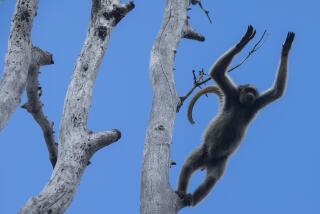Monkeys of Gibraltar
- Share via
GIBRALTAR — The Rock is a legend.
Tarry a few hours or a few days and you will get a royal greeting from what may be the world’s most unusual reception. A committee of golden-brown macaque monkeys, which are known as the “apes of Gibraltar.”
As the only simians still roaming wild in Europe, Gibraltar’s beloved mascots live among the gun emplacements in two separate packs on top of the windy limestone heights of the Rock (altitude: 1,400 feet).
Friendly and playful by nature, the no-tail monkeys love tourists. Visitors feed them chocolates, candies, nuts, fruits and ice cream cones.
Pose for Camera
For half of a banana, you will always find one furry animal who’ll give you a handshake or pose for camera shots.
The monkeys are such big hits that one New York City tourist has been sending them packages of peanuts for many years.
Several universities have dispatched research teams to Gibraltar to find out more about the monkeys, a type of social animal that lives in family and community units.
Weighing about 60 pounds at maturity, most of them live to 15 years. Also, no scientist has yet been able to find out what happens to a dead monkey, since no one has ever found a body or a skeleton in the 1,000 years of monkey life on the Rock.
Numbering about 40, the monkeys can be reached by cable car up the west slope, a rather scary ride that nevertheless offers a stunning panorama of the bay and the Spanish town of Algeciras.
If you wait until 4 p.m., the animals will come down from their heights to a lower perch (reachable by taxi) for their daily feeding (provided by the British Army with an allowance of 15 pence per head per day).
They are fed the usual ration of bananas (which contain hidden vitamin pills), oatmeal, sweet potatoes and green vegetables. This supplements the wild berries, roots, seeds and insects that the monkeys eat on their own.
Manners Are Bad
However, the monkeys--supposedly pals of humans--are easily upset by quick movements or sudden noises.
They also have bad manners. If they see something they want, they’ll grab it. Just ask somebody who has tried to feed them peanuts one at a time only to have the bag rudely snatched away.
There was one monkey, a female, who stole mirrors and took them to her lair, where she spent time admiring herself before smashing them to pieces.
During the height of the tourist season, when about 300,000 people visit, the monkeys also have been known to filch a purse or two and to run off with a camera.
But don’t strike back. Anyone who molests a Gibraltar monkey faces a prison term or a fine, for the Macaca sylvana species enjoys the protection of the British government through a special keeper, a sergeant-at-arms whose responsibility it is to see that they are nurtured and kept in good health.
This latter responsibility includes giving the monkeys whiskey when they catch colds--a most delicate maneuver since the frolicsome animals can’t be corraled so easily.
Churchill Paid Visit
Even Winston Churchill, though beset in 1944 with crises on all fronts, engaged in some important monkey business at the Rock.
While on his way to the Tehran Conference, Winnie stopped at the bastion (2 1/4 square miles in area) to see how the frisky quadrupeds were getting along.
Shocked to hear that their numbers had dwindled to under 10, he let it be known that the survival of the apes of Gibraltar was a matter of concern to the Prime Minister and that their number thereafter was to be kept above 24.
There’s a saying among Gibraltar’s 30,000 inhabitants (most of whom are British subjects), that if the monkeys ever disappear, then the British will also go away. Thus, whenever a baby simian is born, the army records the birth with a flourish befitting the glory of the British Empire.
The Barbary monkey is so held in esteem by British officialdom that when the first decimal coin--in the denomination of 25 new pence--was put out in 1971, it contained a portrait of Queen Elizabeth II and Gibraltar’s monkey on the reverse side.
-- -- --
Many cruise lines stop at Gibraltar as a port of call. British Airways has flights from London (it takes about two hours). From Madrid there is a weekly flight on British Airways.
The expensive Rock Hotel has 160 rooms, with balconies that overlook the sea, most with private bath. The Caleta Palace Hotel, with 200 rooms, stands on a cliff overhanging the village of Catalan Bay. Also expensive. The Montarik Hotel (87 rooms) has a sun terrace with a fine view of sea and sunsets and is less expensive.
As for restaurants, La Bayuca, Spanish specialties; Winston’s, English fare, and the Mermaid, seafood, are excellent, though pricey.
More to Read
Sign up for The Wild
We’ll help you find the best places to hike, bike and run, as well as the perfect silent spots for meditation and yoga.
You may occasionally receive promotional content from the Los Angeles Times.





